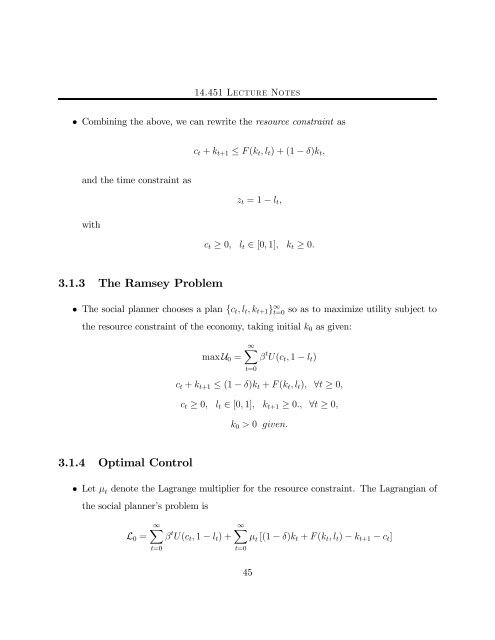14.451 Lecture Notes Economic Growth
14.451 Lecture Notes Economic Growth
14.451 Lecture Notes Economic Growth
Create successful ePaper yourself
Turn your PDF publications into a flip-book with our unique Google optimized e-Paper software.
<strong>14.451</strong> <strong>Lecture</strong> <strong>Notes</strong><br />
• Combining the above, we can rewrite the resource constraint as<br />
and the time constraint as<br />
with<br />
3.1.3 The Ramsey Problem<br />
ct + kt+1 ≤ F (kt,lt)+(1− δ)kt,<br />
zt =1− lt,<br />
ct ≥ 0, lt ∈ [0, 1], kt ≥ 0.<br />
• The social planner chooses a plan {ct,lt,kt+1} ∞ t=0 so as to maximize utility subject to<br />
the resource constraint of the economy, taking initial k0 as given:<br />
3.1.4 Optimal Control<br />
max U0 =<br />
∞X<br />
β t U(ct, 1 − lt)<br />
t=0<br />
ct + kt+1 ≤ (1 − δ)kt + F (kt,lt), ∀t ≥ 0,<br />
ct ≥ 0, lt ∈ [0, 1], kt+1 ≥ 0., ∀t ≥ 0,<br />
k0 > 0 given.<br />
• Let µ t denote the Lagrange multiplier for the resource constraint. The Lagrangian of<br />
the social planner’s problem is<br />
L0 =<br />
∞X<br />
β t U(ct, 1 − lt)+<br />
t=0<br />
∞X<br />
t=0<br />
45<br />
µ t [(1 − δ)kt + F (kt,lt) − kt+1 − ct]

















